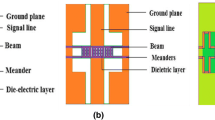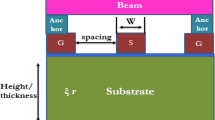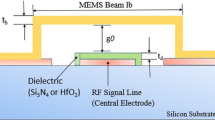Abstract
This Paper reports on investigation of High Con Coff ratio Capacitive Shunt RF MEMS Switch and detailed comparison between uniform three meander beam with non-uniform single meander beam RF MEMS switch. RF MEMS Switches are designed for operation in the range 5–40 GHz. Pull in analysis is performed with gold as a beam material. Simulation reveals that use of high K dielectric material can drastically improve the capacitance ratio of switch. For the same geometry, pull in voltage is 2.45 V for HfO2, 2.7 V for Si3N4 and Capacitive Ratio of the switch with Si3N4 is 83.75 and Capacitive Ratio with HfO2 is 223 at 2g0 (air gap) and 0.8 μm thickness of beam. The Radio Frequency performance of RF MEMS switch is obtained by scattering parameters (insertion loss, Return loss and isolation) which are mainly dominated by down to up capacitance ratio and MEMS bridge geometries. RF analysis shows that insertion loss as low as −0.4 dB at 20 GHz and isolation as high as 80 dB at 20 GHz can be achieved. Investigation of three uniform meander Design and non-uniform single meander design reveals that use of non-uniform design reduces the design complexity and saves substrate area still maintaining almost same device performance. S-parameter analysis is carried out to compare device performance for both structures. DC analysis of the proposed switch is carried out using Coventorware and RF analysis is performed in MATLAB.













Similar content being viewed by others
References
Balaraman D, Bhattacharya SK, Ayazi F, Papapolymerou J (2002) Low-cost low actuation voltage copper RF MEMS switches. IEEE Microwav Theory Tech Symp 2:1225–1228
Bedier M, AbdelRassoul R (2013) Analysis and simulation of serpentine suspensions for MEMS applications. Int J Mater Sci Eng 1(2). doi:10.12720/ijmse.1.2.82-85
Fedder GK (1994) Simulation of microelectromechanical systems. Ph.D. dissertation, Electrical Engineering and Computer Science, University of California at Berkeley, USA
Hijazi YS, Vlasov YA, Larkins GS (2003) Design of a superconducting MEM shunt switch for RF applications. IEEE Trans Appl Supercond 13:696–699
Jaspreet MH et al (2014) Methods for the minimization of actuation voltage in MEMS. Int J Eng Res Appl 4(3) (Version 5):23–27. ISSN: 2248-9622
Mafinejad Y et al (2012) Low actuation wideband RF MEMS shunt capacitive switch. International workshop on information and electronics engineering (IWIEE), Procedia Eng 29:1292–1297
Muldavin JB, Rebeiz GM (2000) High isolation CPW RF MEMS shunt switches—part 1: modelling. IEEE Trans Microwav Theory Tech 48(6):1045–1052
Ramli N, Sidek O (2012) Reducing an actuation voltage of RF MEMS capacitive switch through three electrodes topology using architect coventorware. J Eng Technol 2(2):46–51. ISSN 2231-8798
Rayit AK (1997) Characteristics and Applications of Coplanar Wave Guide and its Discontinuities. Ph.D Thesis, University of Bradford, Bradford,U.K
Rebeiz GM (2003) RF MEMS: theory, design, and technology, 3rd edn. Wiley, New Jersey
Rizk JB, Muldavin JB, Tan GL, Rebeiz GM (2000) Design of X-band MEMS microstrip shunt switches. 30th European Microwave, conference, pp 1–4
Sharma AK, Gupta N (2012) Material selection of RF-MEMS switch used for reconfigurable antenna using Ashby’s methodology. Progr Electromagn Res Lett 31:147–157
Sharma AK, Gupta N (2013) Switching time analysis for non-uniform serpentine flexure based RF-MEMS switches. IEEE, 2nd Students’ Conference on Engineering and Systems (SCES 2013), MNNIT Allahabad, India
Sharma AK, Gupta N (2014) Investigation of actuation voltage for non-uniform serpentine flexure design of RF-MEMS switch. Springer Microsyst Technol 20:413–418. doi. 10.1007/s00542-013-1930-9
Singh T (2013) Effective stress modeling of membranes made of gold and aluminum materials used in radio-frequency microelectromechanical system switches. Trans Electr Electron Mater 14(4):172–176
Taye J, Guha K, Baishya S (2013) Design and analysis of RF MEMS shunt capacitive switch for low actuation voltage and high capacitance ratio. Phys Semicond Dev. Springer international publishing Switzerland, pp 445–448. doi:10.1007/978-319-03002-9_11
Verma P, Singh S (2013) Design and simulation of RF MEMS capacitive type shunt switch & its major applications. IOSR J Electr Commun Eng (IOSR-JECE) e-ISSN: 2278-2834, p-ISSN: 2278-8735. 4(5):60–68
Author information
Authors and Affiliations
Corresponding author
Rights and permissions
About this article
Cite this article
Guha, K., Kumar, M., Parmar, A. et al. Performance analysis of RF MEMS capacitive switch with non uniform meandering technique. Microsyst Technol 22, 2633–2640 (2016). https://doi.org/10.1007/s00542-015-2545-0
Received:
Accepted:
Published:
Issue Date:
DOI: https://doi.org/10.1007/s00542-015-2545-0




